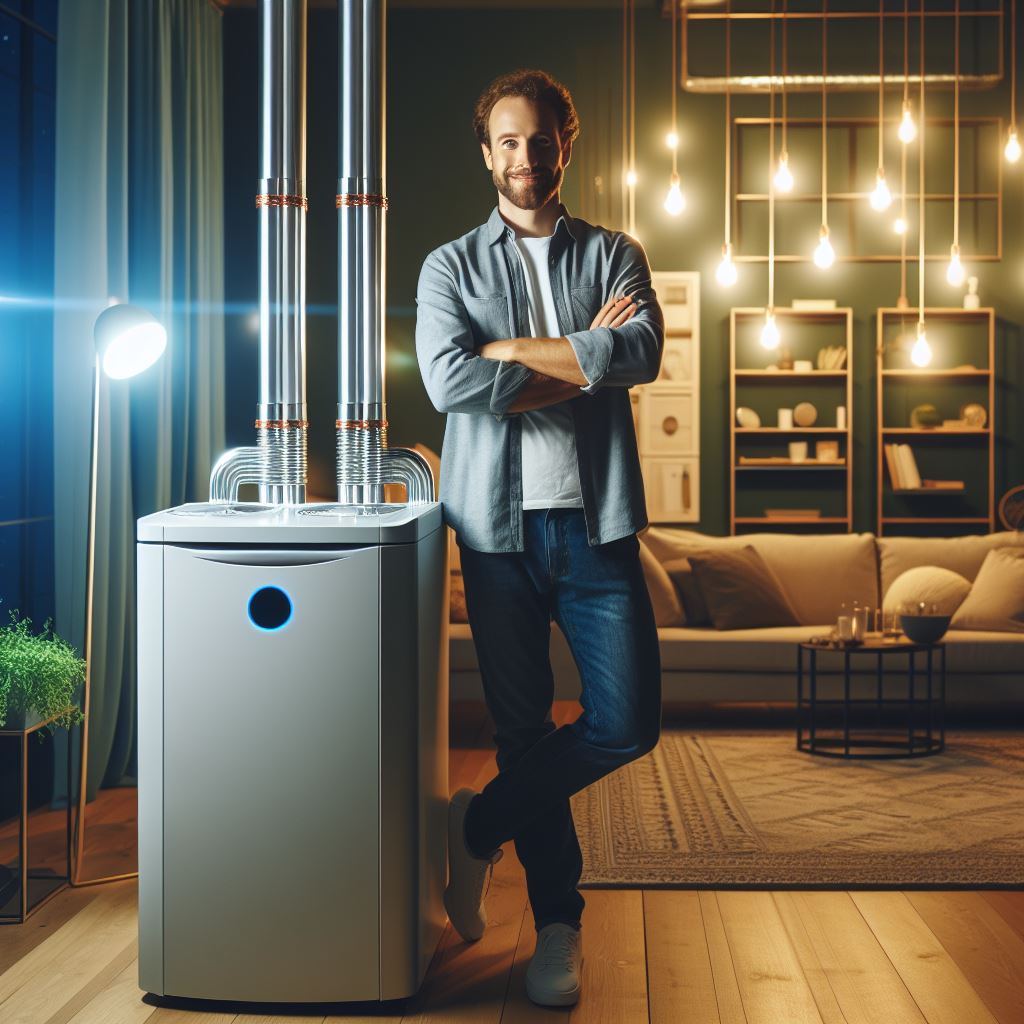Introduction
Energy-efficient HVAC systems play a crucial role in ensuring optimal energy usage and sustainability in properties.
Energy-efficient HVAC upgrades are becoming increasingly essential in properties worldwide.
These systems are designed to optimize energy consumption while ensuring comfort and air quality.
With rising energy costs and growing environmental concerns, property owners and managers need to embrace the advantages of energy-efficient HVAC systems.
By upgrading to energy-efficient HVAC systems, property owners can experience substantial cost savings.
These upgrades not only reduce energy bills but also increase the property’s value and appeal to potential tenants or buyers.
Moreover, energy-efficient systems can lower maintenance and repair costs, ensuring long-term savings for the property owner.
Apart from cost savings, energy-efficient HVAC upgrades have significant environmental benefits.
By reducing energy consumption, they contribute to the global effort of minimizing carbon emissions and combating climate change.
By utilizing renewable energy sources and advanced technologies, such as geothermal or solar power, these upgrades help create a more sustainable future.
Additionally, energy-efficient HVAC systems provide enhanced comfort and air quality for occupants.
With precise temperature control, these systems can create a comfortable environment throughout the year.
Furthermore, they improve air filtration and circulation, reducing allergens, pollutants, and potential health risks for occupants.
In fact, the importance of energy-efficient HVAC upgrades cannot be overstated.
These upgrades offer numerous benefits, including cost savings, environmental sustainability, and enhanced comfort and air quality.
Transform Your Real Estate Decisions
Unlock personalized real estate insights crafted just for you. Get actionable advice designed to amplify your success.
Get StartedProperty owners should consider investing in these upgrades to optimize their properties’ energy usage and provide a healthier and more sustainable environment for occupants.
Understanding Energy-Efficient HVAC Systems
When it comes to enhancing the sustainability of your property, a crucial focus lies in upgrading your HVAC systems.
A firm grasp of energy-efficient HVAC systems is fundamental to achieving this goal.
Definition and Components of HVAC Systems
HVAC stands for Heating, Ventilation, and Air Conditioning.
It is a comprehensive system responsible for maintaining optimal indoor conditions.
The components include heating units, ventilation systems, and air conditioning units, all working in harmony to regulate temperature, humidity, and air quality.
Key Features and Technologies of Energy-Efficient HVAC Systems
- Variable Speed Motors: Energy-efficient HVAC systems often employ variable speed motors. Unlike traditional systems that operate at a constant speed, these motors adjust their speed based on the current heating or cooling demands. This results in significant energy savings as the system doesn’t work harder than necessary.
- Smart Thermostats: Smart thermostats revolutionize temperature control by learning your preferences and adjusting settings accordingly. They can be remotely controlled through mobile applications, allowing users to optimize heating and cooling based on occupancy patterns. This adaptability minimizes energy consumption and reduces utility bills.
- Zoning Systems: Zoning divides a property into distinct zones with individualized climate control. By directing conditioned air only to the zones in use, zoning systems prevent energy wastage in unoccupied spaces. This targeted approach enhances comfort while saving energy, making it a key feature in energy-efficient HVAC systems.
- Energy Recovery Ventilation (ERV) Units: ERV units ensure efficient ventilation by recovering and exchanging heat and moisture from stale indoor air with fresh outdoor air. This process maintains indoor air quality while reducing the load on the heating and cooling systems. As a result, energy-efficient HVAC systems equipped with ERV units contribute to a sustainable and healthy indoor environment.
In fact, understanding the components and technologies of energy-efficient HVAC systems is paramount for property owners looking to make eco-friendly upgrades.
Incorporating variable speed motors, smart thermostats, zoning systems, and ERV units can lead to substantial energy savings, fostering both environmental stewardship and cost-effectiveness.
Read: Green Pest Control in Property Management
Assessing the Need for HVAC Upgrades
When it comes to energy-efficient upgrades in a property, assessing the need for HVAC improvements is crucial.
By evaluating the current system’s efficiency and performance, it’s possible to determine whether an upgrade is necessary.
Evaluating the current HVAC system’s efficiency and performance
The first step is to evaluate the existing HVAC system’s efficiency and performance.
Consider factors such as its age, maintenance history, and energy consumption.
Older systems typically have lower efficiency ratings and are more prone to issues.
Showcase Your Real Estate Business
Publish your company profile on our blog for just $200. Gain instant exposure and connect with a dedicated audience of real estate professionals and enthusiasts.
Publish Your ProfileIdentifying signs of inefficiency and potential issues
Identifying signs of inefficiency and potential issues can help determine the need for upgrades.
High energy bills are a clear indication that the HVAC system is consuming excessive energy.
This could be due to outdated technology or inefficient components.
Uneven heating or cooling throughout the property is another red flag.
If certain areas are colder or warmer than others, it may be a sign that the system is not distributing air properly.
Inefficient HVAC systems struggle to maintain consistent temperatures throughout a building.
Excessive noise coming from the HVAC system could also suggest inefficiency.
Modern units are designed to operate quietly, so any loud or unusual sounds may indicate faulty components or poor maintenance.
Upgrading to a quieter system can improve comfort and reduce noise pollution.
Frequent repairs are another indication that an HVAC upgrade may be necessary.
Over time, outdated systems are more likely to develop issues that require constant maintenance.
These repair costs can add up, making an upgrade a more cost-effective solution in the long run.
Considering the property’s specific requirements and usage patterns
Considering the property’s specific requirements and usage patterns is also essential.
Different properties have varying needs in terms of heating and cooling.
Factors such as the square footage, number of occupants, and climate conditions should all be taken into account when determining the most suitable HVAC system.
For example, a commercial building with high occupancy will require a more robust HVAC system to cater to the increased demand.
On the other hand, a residential property may have specific zoning requirements or the need for individual temperature control in each room.
By assessing these factors, property owners can make informed decisions about HVAC upgrades.
Upgrading to a more energy-efficient system can result in significant long-term savings, improved comfort, and reduced environmental impact.
In short, evaluating the current efficiency and performance of the HVAC system, identifying signs of inefficiency and potential issues, and considering the property’s specific requirements are all crucial in assessing the need for energy-efficient HVAC upgrades.
Taking these steps will help property owners make informed decisions and achieve optimal HVAC performance.
Read: Rental Property Cash Flow: Optimizing Your Income

Choosing the Right Energy-Efficient HVAC Upgrades
Conducting a thorough energy audit
Before making any decisions, it is crucial to conduct a comprehensive energy audit of the property.
This audit helps identify areas of high energy consumption and potential inefficiencies in the HVAC system.
By assessing the current system’s performance, it becomes easier to determine the necessary upgrades for improved energy efficiency.
Consulting with HVAC professionals
Seeking advice from HVAC professionals is essential in making informed decisions about energy-efficient upgrades.
These experts have the necessary knowledge and experience to assess the property and recommend suitable upgrades.
They can provide insights into the most effective upgrades based on specific needs and budget constraints.
Considering factors such as budget, property size, and climate
Various factors must be taken into account when choosing energy-efficient HVAC upgrades.
Firstly, the available budget will determine the extent and type of upgrades that can be considered.
Showcase Your Real Estate Business
Publish your company profile on our blog for just $200. Gain instant exposure and connect with a dedicated audience of real estate professionals and enthusiasts.
Publish Your ProfileNext, it is important to consider the property size and layout as different upgrades suit different spaces.
Additionally, the climate of the region should be considered to ensure the HVAC system can effectively handle temperature extremes.
Comparing different energy-efficient HVAC options available in the market
There are numerous energy-efficient HVAC options available in the market, so it is important to compare them.
Consider the energy efficiency ratings of each system, such as SEER (Seasonal Energy Efficiency Ratio) for air conditioners.
Look for systems with higher ratings as they indicate better energy efficiency and potential cost savings in the long run.
Furthermore, consider features like smart thermostats, variable-speed motors, and zoned heating and cooling for additional efficiency benefits.
Basically, choosing the right energy-efficient HVAC upgrades requires careful consideration and evaluation.
Conducting a thorough energy audit provides valuable insights into the current system’s performance and areas for improvement.
Consulting with HVAC professionals ensures expert advice and recommendations tailored to the property’s specific needs.
Considering factors such as budget, property size, and climate helps narrow down the options.
Lastly, comparing different energy-efficient HVAC options allows for selecting the most suitable system with the highest energy efficiency ratings.
By making the right choices, property owners can achieve significant energy savings while maintaining optimal indoor comfort.
Read: Eco-Friendly Cleaning in Property Management
Potential Energy-Efficient HVAC Upgrades for Properties
Upgrading to a higher SEER-rated air conditioner or heat pump
One of the most effective ways to improve the energy efficiency of your property’s HVAC system is by upgrading to a higher Seasonal Energy Efficiency Ratio (SEER)-rated air conditioner or heat pump.
SEER ratings measure the cooling efficiency of air conditioners and heat pumps, with higher ratings indicating greater efficiency.
By investing in a new unit with a higher SEER rating, you can significantly reduce energy consumption and lower utility bills.
These upgrades often pay for themselves through energy savings over time.
Installing programmable or smart thermostats for temperature control
Programmable or smart thermostats are another valuable upgrade for energy-efficient HVAC systems.
These thermostats allow you to schedule temperature adjustments based on your daily routine and occupancy patterns.
By programming specific temperature settings for different times of the day, you can avoid unnecessary heating or cooling when the property is unoccupied.
This feature helps to save energy and maximize comfort by ensuring optimal temperature levels whenever needed.
Implementing zoning systems for improved comfort and energy savings
Zoning systems divide a property into different areas or zones, each with its own thermostat and independent temperature control.
This allows you to customize heating and cooling levels based on specific needs and usage patterns.
With zoning systems, you can avoid over-conditioning unused areas of the property and redirect airflow where it is most needed.
This leads to improved comfort and significant energy savings, as the HVAC system operates more efficiently by only conditioning occupied spaces.
Adding energy recovery ventilation (ERV) units for better indoor air quality
Energy recovery ventilation (ERV) units are designed to exchange stale indoor air with fresh outdoor air while recovering the energy contained in the exhaust air.
These units include a heat exchanger that transfers the temperature and humidity of the outgoing air to the incoming air.
By using ERV units, your property can maintain proper ventilation while reducing the load on the HVAC system.
This results in improved indoor air quality, reduced energy consumption, and lower utility costs.
Incorporating solar-powered HVAC systems and renewable energy sources
For properties looking to maximize energy efficiency and reduce their carbon footprint, solar-powered HVAC systems and renewable energy sources offer excellent options.
Showcase Your Real Estate Business
Publish your company profile on our blog for just $200. Gain instant exposure and connect with a dedicated audience of real estate professionals and enthusiasts.
Publish Your ProfileSolar-powered HVAC systems utilize solar energy to generate electricity for heating and cooling.
These systems can significantly reduce reliance on the grid and minimize energy consumption and greenhouse gas emissions.
Additionally, incorporating other renewable energy sources such as wind or geothermal energy can further enhance the sustainability of your property’s HVAC system.
These sources provide clean, abundant energy that can be utilized to power HVAC operations while reducing environmental impact.
All in all, there are several potential energy-efficient HVAC upgrades available for properties.
By upgrading to higher SEER-rated units, installing programmable or smart thermostats, implementing zoning systems, adding ERV units, and incorporating solar-powered systems and other renewable energy sources, you can achieve improved energy efficiency, lower utility bills, and enhanced comfort and air quality in your property.
Read: Streamlining Expenses in Property Management
Financing and Incentives for Energy-Efficient HVAC Upgrades
Exploring available financing options for HVAC upgrades
When considering energy-efficient HVAC upgrades for a property, it’s essential to explore the various financing options available.
This allows property owners to make informed decisions regarding their investment and ensure they can afford the upgrades.
One common financing option is through traditional loans offered by banks and credit unions.
These loans provide property owners with the necessary funds to complete the HVAC upgrades and are typically repaid over an extended period.
However, it’s essential to carefully review the loan terms, interest rates, and fees associated with these financing options.
Another financing option to consider is an Energy Efficient Mortgage (EEM).
EEMs are specialized loans that allow property owners to finance the cost of energy-efficient upgrades, including HVAC systems, as part of their mortgage.
These loans often come with lower interest rates and extended repayment terms, making them more attractive to property owners.
Additionally, some HVAC manufacturers and contractors offer in-house financing programs.
These programs allow property owners to work directly with the manufacturer or contractor to finance the HVAC upgrades.
While these programs may have higher interest rates or fees, they can provide a more streamlined and convenient financing process.
Researching local, state, and federal incentives and rebates
In addition to exploring financing options, researching available incentives and rebates can significantly reduce the upfront cost of energy-efficient HVAC upgrades.
There are often local, state, and federal programs designed to encourage property owners to invest in energy-efficient technologies.
Local utility companies frequently offer incentives and rebates for upgrading to energy-efficient HVAC systems.
These incentives can take the form of cash rebates or discounted rates on energy bills.
Researching and understanding these programs can help property owners maximize their savings and decrease their payback period.
State and federal governments also provide various incentives and tax credits for energy-efficient upgrades.
The Database of State Incentives for Renewables & Efficiency (DSIRE) is a comprehensive online resource that outlines the available incentives and rebates in each state.
Utilizing this tool can help property owners identify and take advantage of potential financial assistance.
Calculating the potential return on investment (ROI) for energy-efficient upgrades
Before making any financial decisions regarding energy-efficient HVAC upgrades, it’s crucial to calculate the potential return on investment (ROI).
By assessing the long-term financial benefits of the upgrades, property owners can determine if the investment is worthwhile.
To calculate the ROI, property owners should consider the cost of the HVAC upgrades, including installation and any associated fees or financing charges.
They should also estimate the energy savings that the new system will provide compared to the old one. This calculation can be done by analyzing the energy efficiency ratings of the HVAC systems and comparing them to current energy consumption.
Showcase Your Real Estate Business
Publish your company profile on our blog for just $200. Gain instant exposure and connect with a dedicated audience of real estate professionals and enthusiasts.
Publish Your ProfileOnce the cost and estimated savings have been calculated, property owners can determine the payback period for the investment.
This is the time it takes for the energy savings to cover the cost of the upgrades. Generally, shorter payback periods indicate a more favorable ROI.
Essengtially, financing and incentives play a crucial role in enabling property owners to pursue energy-efficient HVAC upgrades.
By exploring available financing options, researching incentives and rebates, and calculating the potential ROI, property owners can make informed decisions and maximize the benefits of their upgrades.
These financial considerations are essential to promote the widespread adoption of energy-efficient HVAC systems and contribute to a sustainable future.
Uncover the Details: Property Insurance: What You Need to Know
Tips and Best Practices for Successful HVAC Upgrades
Hiring qualified HVAC contractors for installation and maintenance
When embarking on energy-efficient HVAC upgrades for your property, the first step is crucial – hiring qualified HVAC contractors.
Opt for professionals with a proven track record in installing and maintaining energy-efficient systems.
A reputable contractor will assess your property’s specific needs, ensuring the right system size and optimal performance.
Verify their credentials, certifications, and customer reviews to make an informed decision.
A well-executed installation not only enhances energy efficiency but also extends the lifespan of your HVAC system.
Regularly maintaining and servicing the HVAC system
Regular maintenance is the cornerstone of a reliable and energy-efficient HVAC system.
Schedule routine inspections and service appointments with your chosen HVAC contractor to keep the system running smoothly.
Change air filters regularly, inspect ductwork for leaks, and clean coils to maximize efficiency.
A well-maintained system operates at peak performance, reducing energy consumption and minimizing the likelihood of costly repairs.
Consider implementing a proactive maintenance plan to stay ahead of potential issues and optimize your system’s efficiency.
Educating property occupants on energy-efficient HVAC usage and habits
A successful energy-efficient HVAC upgrade doesn’t stop with the installation – it extends to the habits of the property occupants.
Educate residents and staff on the importance of energy conservation and how their actions impact the system’s efficiency.
Encourage setting thermostats to moderate temperatures, using programmable thermostats, and keeping doors and windows closed when the HVAC system is running.
Simple changes in behavior can significantly contribute to energy savings.
Provide informational materials and conduct workshops to promote awareness and foster a collective commitment to sustainability.
Ultimately, the success of energy-efficient HVAC upgrades in a property lies in a combination of professional expertise, regular maintenance, and a commitment to sustainable habits.
By hiring qualified contractors, prioritizing maintenance, and educating occupants, you not only enhance the efficiency of your HVAC system but also contribute to a greener and more sustainable environment.
Conclusion
In the journey towards sustainable living, energy-efficient HVAC upgrades stand out as transformative solutions.
As we’ve explored in this blog series, these upgrades offer a myriad of benefits.
They not only reduce energy consumption but also lower utility bills, contribute to environmental conservation, and enhance overall comfort within a property.
By optimizing heating, ventilation, and air conditioning systems, property owners can create a healthier and more sustainable living environment.
Now, armed with knowledge about the positive impacts of energy-efficient HVAC upgrades, the next step is action.
The significance of making these improvements cannot be overstated.
It’s an investment not just in the property itself but in a greener and more responsible future.
Showcase Your Real Estate Business
Publish your company profile on our blog for just $200. Gain instant exposure and connect with a dedicated audience of real estate professionals and enthusiasts.
Publish Your ProfileEnergy-efficient upgrades not only benefit the environment but also result in significant cost savings over time.
The initial investment pays off through reduced energy bills, making it a wise decision for both your wallet and the planet.
Consider consulting with HVAC professionals to assess your property’s specific needs and identify the most suitable upgrades.
Whether it’s upgrading insulation, installing smart thermostats, or investing in energy-efficient HVAC systems, every step counts towards a more sustainable future.
As we conclude, it’s essential to reflect on the long-term impact of energy-efficient upgrades.
Beyond the immediate benefits of lower energy bills, these upgrades position properties as environmentally responsible and forward-thinking.
They contribute to the global effort to mitigate climate change and create a more sustainable world for future generations.
In the grand scheme of things, individual actions accumulate to shape a collective impact.
Every energy-efficient upgrade made today ripples into a more sustainable and energy-conscious tomorrow.
By taking responsibility for our properties and making eco-friendly choices, we become stewards of a healthier planet.
In essence, the journey towards energy efficiency in HVAC systems is a commitment to a better, more sustainable future—one property at a time.
So, let’s take the reins, make informed choices, and embark on a path that not only benefits us today but leaves a positive legacy for the generations that follow.




